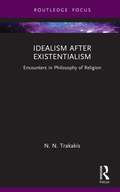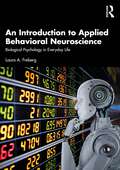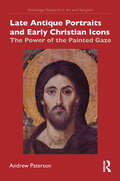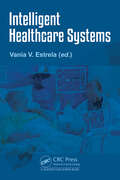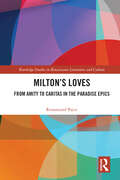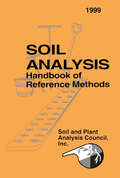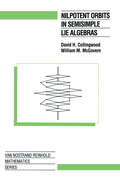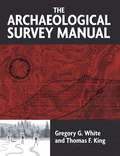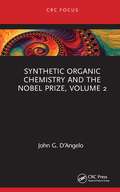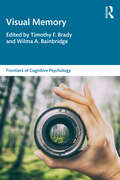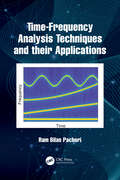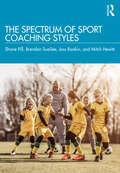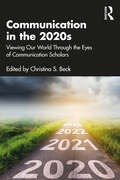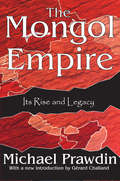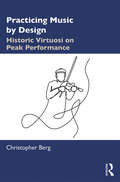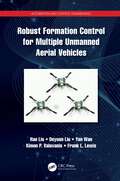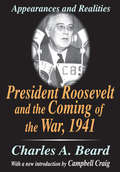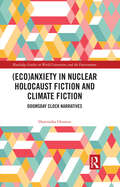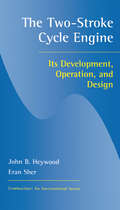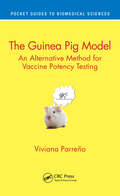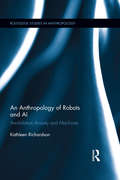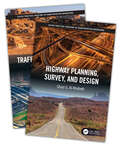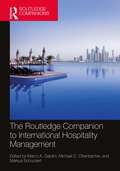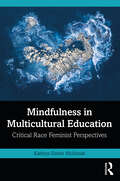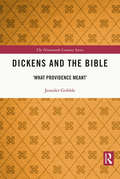- Table View
- List View
Idealism after Existentialism: Encounters in Philosophy of Religion (Routledge Focus on Philosophy)
by N. N. TrakakisA century ago the dominant philosophical outlook was not some form of materialism or naturalism, but idealism. However, this way of thinking about reality fell out of favour in the Anglo-American analytic tradition as well as the Continental schools of the twentieth century.The aim of this book is to restage and reassess the encounter between idealism and contemporary philosophy. The idealist side will be represented by the great figures of the 19th-century post-Kantian tradition in Germany, from Fichte and Schelling to Hegel, followed by the towering Hegelians in Britain led by T. H. Green, F. H. Bradley and Bernard Bosanquet. Their twentieth-century adversaries will be represented by the secular existentialists, especially the famous French trio of Sartre, Beauvoir and Camus, who sought to follow Nietzsche in philosophizing in light of the death of God. And the arena of encounter will be the philosophy of religion—more specifically, questions relating to the nature and existence of God, death and the meaning of life, and the problem of evil. The book argues that the existentialist critique of idealism enables an innovative as well as a more critical and adventurous approach that is sorely needed in philosophy of religion today.Idealism after Existentialism will be of interest to scholars and advanced students working in the history of ninteenth- and twentieth-century philosophy and philosophy of religion.
An Introduction to Applied Behavioral Neuroscience: Biological Psychology in Everyday Life
by Laura A. FrebergAn Introduction to Applied Behavioral Neuroscience explores the connection between neuroscience and multiple domains, including psychological disorders, forensics, education, consumer behavior, economics, leadership, health, and robotics and artificial intelligence. The book ensures students have a solid foundation in the history of behavioral neuroscience; its applicability to other facets of science and policy, and a good understanding of major methodologies and their limitations to aiding critical thinking skills. Written in a student-friendly style, it provides a highly accessible introduction to the major structural and functional features of the human nervous system. It then discusses applications across a variety of areas in society, including how behavioral neuroscience is used by the legal system, in educational practice, advertising, economics, leadership, the development of and recovery from health challenges, and in robotics. Each of the application-specific chapters present the problems that neuroscience is being asked to address, the methods being used, and the challenges and successes experienced by scholars and practitioners in each domain. It is a must-read for all advanced undergraduate and postgraduate students in biological psychology, neuroscience, and clinical psychology who want to know what neuroscience can really do to address real-world problems.
Late Antique Portraits and Early Christian Icons: The Power of the Painted Gaze (Routledge Research in Art and Religion)
by Andrew PatersonThis book focuses on the earliest surviving Christian icons, dated to the sixth and seventh centuries, which bear many resemblances to three other well-established genres of ‘sacred portrait’ also produced during late antiquity, namely Roman imperial portraiture, Graeco-Egyptian funerary portraiture and panel paintings depicting non-Christian deities.Andrew Paterson addresses two fundamental questions about devotional portraiture – both Christian and non-Christian – in the late antique period. Firstly, how did artists visualise and construct these images of divine or sanctified figures? And secondly, how did their intended viewers look at, respond to, and even interact with these images? Paterson argues that a key factor of many of these portrait images is the emphasis given to the depicted gaze, which invites an intensified form of personal encounter with the portrait’s subject.The book will be of interest to scholars working in art history, theology, religion and classical studies.
Intelligent Healthcare Systems
by Vania V. EstrelaThe book sheds light on medical cyber-physical systems while addressing image processing, microscopy, security, biomedical imaging, automation, robotics, network layers’ issues, software design, and biometrics, among other areas. Hence, solving the dimensionality conundrum caused by the necessity to balance data acquisition, image modalities, different resolutions, dissimilar picture representations, subspace decompositions, compressed sensing, and communications constraints. Lighter computational implementations can circumvent the heavy computational burden of healthcare processing applications. Soft computing, metaheuristic, and deep learning ascend as potential solutions to efficient super-resolution deployment. The amount of multi-resolution and multi-modal images has been augmenting the need for more efficient and intelligent analyses, e.g., computer-aided diagnosis via computational intelligence techniques. This book consolidates the work on artificial intelligence methods and clever design paradigms for healthcare to foster research and implementations in many domains. It will serve researchers, technology professionals, academia, and students working in the area of the latest advances and upcoming technologies employing smart systems’ design practices and computational intelligence tactics for medical usage. The book explores deep learning practices within particularly difficult computational types of health problems. It aspires to provide an assortment of novel research works that focuses on the broad challenges of designing better healthcare services.
Milton's Loves: From Amity to Caritas in the Paradise Epics (Routledge Studies in Renaissance Literature and Culture)
by Rosamund PaiceThis book is about the multiple loves of Paradise Lost and Paradise Regained: sanctioned loves and outlawed loves, sincere loves and false loves, Christian loves, classical loves, humanist loves, and love as emotion. In showing how these loves motivate the most significant actions of the Paradise epics, it reveals Milton to have made creative use of the tensions between philosophical ideals, social conventions, and the rather messier ways in which love emerges in practice. Love, so central to Milton’s view of Edenic joy and obedience to God, unsettles earthly and heavenly communities and is the origin of Miltonic transgression. Milton’s Loves sheds new light on some of the most prominent concerns of Milton scholarship, including why Milton’s God is so difficult for readers to connect to, Satan’s apparent heroism, Milton’s radical theology, and the nature of Milton’s muse. It is a book that will appeal to students and scholars of Milton and early modern studies more broadly and is structured in a way that will aid easy reference.
Soil Analysis Handbook of Reference Methods
by Soil and Soil and Plant Analysis Council Inc.For more than 30 years, soil testing has been widely used as a basis for determining lime and fertilizer needs. Today, a number of procedures are used for determining everything from soil pH and lime requirement, to the level of extractable nutrient elements. And as the number of cropped fields being tested increases, more and more farmers and growers will come to rely on soil test results. But if soil testing is to be an effective means of evaluating the fertility status of soils, standardization of methodology is essential. No single test is appropriate for all soils.Soil Analysis Handbook of Reference Methods is a standard laboratory technique manual for the most commonly used soil analysis procedures. First published in 1974, this Handbook has changed over the years to reflect evolving needs. New test methods and modifications have been added, as well as new sections on nitrate, heavy metals, and quality assurance plans for agricultural testing laboratories. Compiled by the Soil and Plant Analysis Council, this latest edition of Soil Analysis Handbook of Reference Methods also addresses the major methods for managing plant nutrition currently in use in the United States and other parts of the world. For soil scientists, farmers, growers, or anyone with an interest in the environment, this reference will prove an invaluable guide to standard methods for soil testing well into the future.Features
Nilpotent Orbits In Semisimple Lie Algebra: An Introduction
by William.M. McGovernThrough the 1990s, a circle of ideas emerged relating three very different kinds of objects associated to a complex semisimple Lie algebra: nilpotent orbits, representations of a Weyl group, and primitive ideals in an enveloping algebra. The principal aim of this book is to collect together the important results concerning the classification and properties of nilpotent orbits, beginning from the common ground of basic structure theory. The techniques used are elementary and in the toolkit of any graduate student interested in the harmonic analysis of representation theory of Lie groups. The book develops the Dynkin-Konstant and Bala-Carter classifications of complex nilpotent orbits, derives the Lusztig-Spaltenstein theory of induction of nilpotent orbits, discusses basic topological questions, and classifies real nilpotent orbits. The classical algebras are emphasized throughout; here the theory can be simplified by using the combinatorics of partitions and tableaux. The authors conclude with a survey of advanced topics related to the above circle of ideas. This book is the product of a two-quarter course taught at the University of Washington.
The Archaeological Survey Manual
by Gregory G White Thomas F KingGovernmental guidelines have forced a dramatic change in the practice of archaeological surveying in recent decades. In response to public and private development, surveying is needed to accurately inventory the cultural resources of a region and provide guidance for their preservation and management. Greg White and Tom King provide a handy introduction to students, field novices, and land managers on the strategies, methods, and logic of contemporary survey work. In addition to providing the legal and historical context for this endeavor the book provides a heavily illustrated, practical guide to conducting a survey to help beginners understand how it works in practice. This volume is perfect for an archaeological methods class, field school, or reference collection.
Synthetic Organic Chemistry and the Nobel Prize, Volume 2 (Synthetic Organic Chemistry and the Nobel Prize)
by John G. D'AngeloThe Nobel Prize is the highest award in science, as is the case with nonscience fields too, and it is, therefore, arguably the most internationally recognized award in the world. This unique set of volumes focuses on summarizing the Nobel Prize within organic chemistry, as well as the specializations within this specialty. Any reader researching the history of the field of organic chemistry will be interested in this work. Furthermore, it serves as an outstanding resource for providing a better understanding of the circumstances that led to these amazing discoveries and what has happened as a result, in the years since.
Visual Memory (Frontiers of Cognitive Psychology)
by Timothy F. Brady and Wilma A. BainbridgeFeaturing contributions from world-leading researchers, this book explores the relationship between visual perception and memory. It bridges the traditionally separate fields of vision science and recognition memory and deals with an interdisciplinary set of perspectives combining research in psychology, neuroscience, and artificial intelligence.The book makes new connections between the wealth of research from each respective field, developing the idea that visuospatial memory is our best memory system. This volume traverses topics grounded in both empirical study and real-world applications, including working (short-term) memory, long-term memory, the neuroscience of memory, development of memory over the lifespan, autobiographical memories, false memories, and eyewitness testimony. It argues that an increased knowledge of how visuospatial memory works can lead to an improved understanding of the basic features of memory, as well as providing strategies for memory improvement. The book features cutting edge visual memory research, where converging methods in psychophysics, cognitive neuroscience, and computational modeling have been propelling the field forward. Visual Memory is an essential read for all students and researchers of memory and visual perception. It will also be useful for researchers and students in related fields including human-computer interaction, data visualization, cognitive science, and cognitive enhancement.
Time-Frequency Analysis Techniques and their Applications
by Ram Bilas PachoriMost of the real-life signals are non-stationary in nature. The examples of such signals include biomedical signals, communication signals, speech, earthquake signals, vibration signals, etc. Time-frequency analysis plays an important role for extracting the meaningful information from these signals. The book presents time-frequency analysis methods together with their various applications. The basic concepts of signals and different ways of representing signals have been provided. The various time-frequency analysis techniques namely, short-time Fourier transform, wavelet transform, quadratic time-frequency transforms, advanced wavelet transforms, and adaptive time-frequency transforms have been explained. The fundamentals related to these methods are included. The various examples have been included in the book to explain the presented concepts effectively. The recently developed time-frequency analysis techniques such as, Fourier-Bessel series expansion-based methods, synchrosqueezed wavelet transform, tunable-Q wavelet transform, iterative eigenvalue decomposition of Hankel matrix, variational mode decomposition, Fourier decomposition method, etc. have been explained in the book. The numerous applications of time-frequency analysis techniques in various research areas have been demonstrated. This book covers basic concepts of signals, time-frequency analysis, and various conventional and advanced time-frequency analysis methods along with their applications. The set of problems included in the book will be helpful to gain an expertise in time-frequency analysis. The material presented in this book will be useful for students, academicians, and researchers to understand the fundamentals and applications related to time-frequency analysis.
The Spectrum of Sport Coaching Styles
by Shane Pill Brendan SueSee Joss Rankin Mitch HewittFor the first time, this book applies The Spectrum to sports coaching to become a Spectrum of Coaching Styles. The non-versus approach to pedagogy taken by The Spectrum places athletes or players at the centre of their learning and clearly defines who (player or coach) is making pedagogical decisions in each style. This clarity allows players and coaches to have their teaching behaviours and decision-making clearly defined, and it provides a common language for players, coaches and practitioners to talk about coaching styles and the expected outcomes. For coaches interested in the holistic development of the player/athlete, The Spectrum provides a detailed framework for achieving multiple learning outcomes through cognitive, social, physical, ethical, emotional and social development.Written by coaches for coaches, this book applies Spectrum theory in a coach-specific/friendly way to the following: Introduction to The Spectrum and the sport coach as educator; Summary and detailed description of the 11 coaching styles and their suitability to particular types of coaching episodes; Outlines of the strengths of each style with application examples; and Explanations of coaching to develop reflective practice, self-analysis and error correction, how to coach players to decide on appropriate practice levels or challenge points, player problem solving and solution generation ability. The Spectrum of Sport Coaching Styles is important reading for coaches, athletes, students and lecturers of sports coaching across any sport.
Communication in the 2020s: Viewing Our World Through the Eyes of Communication Scholars
by Christina S. BeckThis book provides an inside look at the discipline of Communication. In this collection of chapters, top scholars from a wide range of subfields discuss how they have experienced and how they study the crucial issues of our time. The 2020s opened with a series of events with massive implications for the ways we communicate, from the COVID-19 pandemic, a summer of protests for social justice, and climate change-related natural disasters, to one of the most contentious presidential elections in modern U.S. history. The chapters in this book provide snapshots of many of these issues as seen through the eyes of specialists in the major subfields of Communication, including interpersonal, organizational, strategic, environmental, religious, social justice, risk, sport, health, family, instructional, and political communication. Written in an informal style that blends personal narrative with accessible explanation of basic concepts, the book is ideal for introducing students to the range and practical applications of Communication discipline. This book comprises a valuable companion text for Introduction to Communication courses as well as a primary resource for Capstone and Introduction to Graduate Studies courses. Further, this collection provides meaningful insights for Communication scholars as we look ahead to the remainder of the 2020s and beyond.
The Mongol Empire: Its Rise and Legacy
by Michael PrawdinIn his prologue to The Mongol Empire, Michael Prawdin sets the stage for the last and mightiest onslaught of the nomads upon the civilized world. He tells of the many rejoicings in Europe over the successes of the Crusaders in A.D. 1221. But little did Europe know that two decades later, the Mongol hordes organized by Genghis Khan would turn the Middle East into a heap of ruins and spread terror throughout the West. A work of enduring scholarship and literary excellence, The Mongol Empire is a classic on the rise and fall of the world's largest empire. It describes the incredible ascent of the Mongol people, which, through the political and military genius of Genghis Khan, overwhelmed and subdued the nations of most of the world. It demonstrates the transformation of barbarous nomads into the most efficient rulers of their time and describes the crumbling of their vast empire and the assumption of its legacy by the formerly subjugated China and Russia. Maurice Collis in Time and Tide said of The Mongol Empire: "It has the rare merit of being both scholarly and exciting...The entire world comes on to his canvas, romantic and fantastical persons pass in our view, and at the conclusion we realize that we have seen the whole of what Marco Polo saw only in part. " while The Observer commented, "it is a fine book, full of dramatic occasion well used, clear in proportions."
Practicing Music by Design: Historic Virtuosi on Peak Performance
by Christopher BergPracticing Music by Design: Historic Virtuosi on Peak Performance explores pedagogical practices for achieving expert skill in performance. It is an account of the relationship between historic practices and modern research, examining the defining characteristics and applications of eight common components of practice from the perspectives of performing artists, master teachers, and scientists. The author presents research past and present designed to help musicians understand the abstract principles behind the concepts. After studying Practicing Music by Design, students and performers will be able to identify areas in their practice that prevent them from developing.The tenets articulated here are universal, not instrument-specific, borne of modern research and the methods of legendary virtuosi and teachers. Those figures discussed include: Luminaries Franz Liszt and Frederic Chopin Renowned performers Anton Rubinstein, Mark Hambourg, Ignace Paderewski, and Sergei Rachmaninoff Extraordinary teachers Theodor Leschetizky, Rafael Joseffy, Leopold Auer, Carl Flesch, and Ivan Galamian Lesser-known musicians who wrote perceptively on the subject, such as violinists Frank Thistleton, Rowsby Woof, Achille Rivarde, and Sydney Robjohns Practicing Music by Design forges old with new connections between research and practice, outlining the practice practices of some of the most virtuosic concert performers in history while ultimately addressing the question: How does all this work to make for better musicians and artists?
Robust Formation Control for Multiple Unmanned Aerial Vehicles (ISSN)
by Hao Liu Deyuan Liu Yan Wan Kimon Valavanis Frank LewisThis book is based on the authors’ recent research results on formation control problems, including time-varying formation, communication delays, fault-tolerant formation for multiple UAV systems with highly nonlinear and coupled, parameter uncertainties, and external disturbances. Differentiating from existing works, this book presents a robust optimal formation approach to designing distributed cooperative control laws for a group of UAVs, based on the linear quadratic regulator control method and the robust compensation theory. The proposed control method is composed of two parts: the nominal part to achieve desired tracking performance and the robust compensation part to restrain the influence of highly nonlinear and strongly coupled parameter uncertainties, and external disturbances on the global closed-loop control system. Furthermore, this book gives proof of their robust properties. The influence of communication delays and actuator fault tolerance can be restrained by the proposed robust formation control protocol, and the formation tracking errors can converge into a neighborhood of the origin bounded by a given constant in a finite time. Moreover, the book provides details about the practical application of the proposed method to design formation control systems for multiple quadrotors and tail-sitters. Additional features include a robust control method that is proposed to address the formation control problem for UAVs and theoretical and experimental research for the cooperative flight of the quadrotor UAV group and the tail-sitter UAV group. Robust Formation Control for Multiple Unmanned Aerial Vehicles is suitable for graduate students, researchers, and engineers in the system and control community, especially those engaged in the areas of robust control, UAV swarming, and multi-agent systems.
President Roosevelt and the Coming of the War, 1941: Appearances and Realities
by Charles BeardConceived by Charles Beard as a sequel to his provocative study of American Foreign Policy in the Making, 1932-1940, President Roosevelt and the Coming of the War outraged a nation, permanently damaging Beard's status as America's most influential historian.Beard's main argument is that both Democratic and Republican leaders, but Roosevelt above all, worked quietly in 1940 and 1941 to insinuate the United States into the Second World War. Basing his work on available congressional records and administrative reports, Beard concludes that FDR's image as a neutral, peace-loving leader was a smokescreen, behind which he planned for war against Germany and Japan even well before the attack on Pearl Harbor.Beard contends that the distinction between aiding allies in Europe like Great Britain and maintaining strict neutrality with respect to nations like Germany and Japan was untenable. Beard does not argue that all nations were alike, or that some did and others did not merit American support, but rather that Roosevelt chose to aid Great Britain secretly and unconstitutionally rather than making the case to the American public. President Roosevelt shifted from a policy of neutrality to one of armed intervention, but he did so without surrendering the appearance, the fiction of neutrality. This core argument makes the work no less explosive in 2003 than it was when first issued in 1948.
**Missing**: Doomsday Clock Narratives (Routledge Studies in World Literatures and the Environment)
by Dominika Oramus(Eco)Anxiety in Nuclear Holocaust Fiction and Climate Fiction: Doomsday Clock Narratives demonstrates that disaster fiction— nuclear holocaust and climate change alike— allows us to unearth and anatomise contemporary psychodynamics and enables us to identify pretraumatic stress as the common denominator of seemingly unrelated types of texts. These Doomsday Clock Narratives argue that earth’s demise is soon and certain. They are set after some catastrophe and depict people waiting for an even worse catastrophe to come. References to geology are particularly important— in descriptions of the landscape, the emphasis falls on waste and industrial bric- a- brac, which is seen through the eyes of a future, posthuman archaeologist. Their protagonists have the uncanny feeling that the countdown has already started, and they are coping with both traumatic memories and pretraumatic stress. Readings of novels by Walter M. Miller, Nevil Shute, John Christopher, J. G. Ballard, George Turner, Maggie Gee, Paolo Bacigalupi, Ruth Ozeki, and Yoko Tawada demonstrate that the authors are both indebted to a century- old tradition and inventively looking for new ways of expressing the pretraumatic stress syndrome common in contemporary society. This book is written for an academic audience (postgraduates, researchers, and academics) specialising in British Literature, American Literature, and Science Fiction Studies.
Two-Stroke Cycle Engine: Its Development, Operation and Design (Combustion)
by JohnB. HeywoodThis book addresses the two-stroke cycle internal combustion engine, used in compact, lightweight form in everything from motorcycles to chainsaws to outboard motors, and in large sizes for marine propulsion and power generation. It first provides an overview of the principles, characteristics, applications, and history of the two-stroke cycle engine, followed by descriptions and evaluations of various types of models that have been developed to predict aspects of two-stroke engine operation.
The Guinea Pig Model: An Alternative Method for Vaccine Potency Testing (Pocket Guides to Biomedical Sciences)
by Viviana ParreñoThis book summarizes the development and statistical validation of a guinea pig model as an alternative for potency testing of the viral antigens included in combined vaccines applied in cattle to control the respiratory, reproductive, and neonatal calf diarrhea syndromes. The model allows, in one serum sample, to test the vaccine quality for all the viral antigens included in aqueous as well as in oil-adjuvanted formulations of bovine vaccines. The methodology proposed for the control of bovine herpes virus, parainfluenza, and rotavirus were recommended by CAMEVET as guidelines for the 30 countries in the forum, including the US.Key Features Reviews combined vaccines used for cattle Summarizes animal models used for vaccine testing Focuses on bovine herpesviruses, rotaviruses, parainfluenza, and bovine viral diarrhea virus Provides guidance on the effectiveness of the Guinea Pig model for testing vaccine immunogenicity
An Anthropology of Robots and AI: Annihilation Anxiety and Machines (Routledge Studies in Anthropology)
by Kathleen RichardsonThis book explores the making of robots in labs at the Massachusetts Institute of Technology (MIT). It examines the cultural ideas that go into the making of robots, and the role of fiction in co-constructing the technological practices of the robotic scientists. The book engages with debates in anthropological theorizing regarding the way that robots are reimagined as intelligent, autonomous and social and weaved into lived social realities. Richardson charts the move away from the “worker” robot of the 1920s to the “social” one of the 2000s, as robots are reimagined as companions, friends and therapeutic agents.
Highway Planning, Survey, and Design
by Ghazi G. Al-KhateebHighway Planning, Survey, and Design presents the latest engineering concepts, techniques, practices, principles, standard procedures, and models that are applied and used to design and evaluate alternatives of transportation systems and roadway horizontal and vertical alignments and to forecast travel demand using variety of trip forecasting models to ultimately achieve greater safety, sustainability, efficiency, and cost-effectiveness. It provides in-depth coverage of the major areas of transportation engineering and includes a broad range of practical problems and solutions, related to theory, concepts, practice, and applications. Solutions for each problem follow step-by-step procedures that include the theory and the derivation of the formulas and computations where applicable. Additionally, numerical methods, linear algebraic methods, and least squares regression techniques are presented to assist in problem solving.Features: Presents coverage of major areas in transportation engineering: urban transportation planning, highway surveying, and geometric design of highways Provides solutions to numerous practical problems in transportation engineering including terminology, theory, practice, computation, and design Offers downloadable and user-friendly MS Excel spreadsheets as well as numerical methods and optimization tools and techniques Includes several practical case studies throughout Implements a unique approach in presenting the different topics Highway Planning, Survey, and Design will help academics and professionals alike to find practical solutions across the broad spectrum of transportation engineering issues.
The Routledge Companion to International Hospitality Management (ISSN)
by Marco A. GardiniThe hospitality sector is facing increasing competition and complexity over recent decades in its development towards a global industry. The strategic response to this is still that hospitality companies try to grow outside their traditional territories and domestic markets, while the expansion patterns and M&A activities of international hotel and restaurant chains reflect this phenomenon. Yet, interestingly, the strategies, concepts, and methods of internationalization as well as the managerial and organizational challenges and impacts of globalizing the hospitality business are under-researched in this industry.While the mainstream research on international management offers an abundance of information and knowledge on topics, players, trends, concepts, frameworks, or methodologies, its ability to produce viable insights for the hospitality industry is limited, as the mainstream research is taking place outside of the service sector. Specific research directions and related cases like the international dimensions of strategy, organization, marketing, sales, staffing, control, culture, and others to the hospitality industry are rarely identifiable so far. The core rationale of this book is therefore to present newest insights from research and industry in the field of international hospitality, drawing together recent scientific knowledge and state-of-the-art expertise to suggest directions for future work. It is designed to raise awareness on the international factors influencing the strategy and performance of hospitality organizations, while analyzing and discussing the present and future challenges for hospitality firms going or being international.This book will provide a comprehensive overview and deeper understanding of trends and issues to researchers, practitioners, and students by showing how to master current and future challenges when entering and competing in the global hospitality industry.
Mindfulness in Multicultural Education: Critical Race Feminist Perspectives
by Kathryn Esther McIntoshGrounded in critical race feminism, this book explores mindfulness as an empowering approach in multicultural education. The author explores how learners of multicultural education—by (re)centering the body through mindfulness with concrete strategies and scaffolded practice—can be empowered to handle the activated emotions and deep self-inquiry that come with the work of social justice, liberation, and anti-racism. This book includes counter stories of students of colors and offers both an epistemological and a curricular approach to mindfulness in multicultural education, including discussion of theory and key principles in addition to ten modules with practices to engage learners. These modules can be directly applied as the basis for curricular changes in teacher education and university-wide social justice courses, or they can be independently read by learners interested in enhancing their wellbeing and social justice. Written for teacher preparation and university social justice courses, this book encourages educators to contextualize their mindfulness practice within a critique of systems of oppression and ask questions about how mindfulness can empower action towards a more just society.
Dickens and the Bible: 'What Providence Meant' (ISSN)
by Jennifer GribbleAt a time when biblical authority was under challenge from the Higher Criticism and evolutionary science, ‘what providence meant’ was the most keenly contested of questions. This book takes up the controversial subject of Dickens and religion, and offers a significant contribution to the interdisciplinary area of religion and literature. In a close study of major novels, it argues that networks of biblical allusion reveal the Judeo-Christian grand narrative as key to his development as a writer, and as the ontological ground on which he stands to appeal to ‘the conscience of a Christian people’. Engaging the biblical narrative in dialogue with other contemporary narratives that concern themselves with origins, destinations, and hermeneutic decipherments, the inimitable Dickens affirms the Bible’s still-active role in popular culture. The providential thinking of two twentieth-century theorists, Bakhtin and Ricoeur, sheds light on an exploration of Dickens’s narrative theology.
